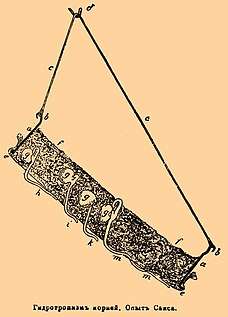Hydrotropism

Hydrotropism (hydro- "water"; tropism "involuntary orientation by an organism, that involves turning or curving as a positive or negative response to a stimulus")[1] is a plant's growth response in which the direction of growth is determined by a stimulus or gradient in water concentration. A common example is a plant root growing in humid air bending toward a higher relative humidity level.
This is of biological significance as it helps to increase efficiency of the plant in its ecosystem.
The process of hydrotropism is started by the root cap sensing water and sending a signal to the elongating part of the root. Hydrotropism is difficult to observe in underground roots, since the roots are not readily observable, and root gravitropism is usually more influential than root hydrotropism.[2] Water readily moves in soil and soil water content is constantly changing so any gradients in soil moisture are not stable.
Root hydrotropism research has mainly been a laboratory phenomenon for roots grown in humid air rather than soil. Its ecological significance in soil-grown roots is unclear because so little hydrotropism research has examined soil-grown roots. Recent identification of a mutant plant that lacks a hydrotropic response may help to elucidate its role in nature.[3] Hydrotropism may have importance for plants grown in space, where it may allow roots to orient themselves in a microgravity environment.[4]
Mechanism
A class of plant hormones called auxins coordinates this root growth process. Auxins play a key role in bending the plants root towards the water because they cause one side of the root to grow faster than the other and thus the bending of the root. The Auxins are also important to plant life because they help search for water.
Misconceptions
- The greater growth of roots in moist soil zones than in dry soil zones is not usually a result of hydrotropism.[5] Hydrotropism requires a root to bend from a drier to a wetter soil zone. Roots require water to grow so roots that happen to be in moist soil will grow and branch much more than those in dry soil.
- Roots cannot sense water inside intact pipes via hydrotropism and break the pipes to obtain the water.
- Roots cannot sense water several feet away via hydrotropism and grow toward it. At best hydrotropism probably operates over distances of a couple millimeters″
References
- ↑ condensed definitions, Webster's New Collegiate Dictionary
- ↑ Takahashi N, Yamazaki Y, Kobayashi A, Higashitani A, Takahashi H (June 2003). "Hydrotropism interacts with gravitropism by degrading amyloplasts in seedling roots of Arabidopsis and radish". Plant Physiol. 132 (2): 805–810. doi:10.1104/pp.102.018853. PMC 167020. PMID 12805610.
- ↑ Eapen D, Barroso ML, Campos ME, et al. (February 2003). "A no hydrotropic response root mutant that responds positively to gravitropism in Arabidopsis". Plant Physiol. 131 (2): 536–546. doi:10.1104/pp.011841. PMC 166830. PMID 12586878.
- ↑ Takahashi H, Brown CS, Dreschel TW, Scott TK (May 1992). "Hydrotropism in pea roots in a porous-tube water delivery system". HortScience. 27 (5): 430–432. PMID 11537612.
- ↑ Hershey DR (1993). "Is hydrotropism all wet?". Science Activities. 29 (2): 20–24.
- Eapen D, Barroso ML, Ponce G, Campos ME, Cassab GI (January 2005). "Hydrotropism: root growth responses to water". Trends Plant Sci. 10 (1): 44–50. doi:10.1016/j.tplants.2004.11.004. PMID 15642523.